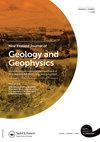抬升的混合沙和砾石海滩的地貌响应:结合来自Kaikōura,新西兰的短期观测和长期证据
IF 1.9
4区 地球科学
Q1 GEOLOGY
New Zealand Journal of Geology and Geophysics
Pub Date : 2021-11-12
DOI:10.1080/00288306.2021.1994425
引用次数: 2
摘要
2016年11月14日,新西兰南岛东北海岸发生7.8 Mw地震,导致Kaikōura半岛周边瞬间抬升约1 m。本文记录了一项独特的实地研究,研究了Kaikōura混合沙和砾石(MSG)海滩对该事件导致的相对海平面下降的短期反应。我们提出了两个概念性的响应路径模型,考虑了18个沿海地点的震前趋势,并在地震后22个月的时间内进行了两次调查,以确定MSG海滩对瞬时相对海平面下降的短期响应。研究发现,根据地震前沉积物供应、震源连通性和开放海岸暴露特征,MSG海滩响应存在较大差异。总的来说,在地震后的短期环境中,海滩有两个主要的趋势:增生剖面和侵蚀剖面。这两种剖面响应类型之间的差异可以总结为:地震前侵蚀剖面在地震后22个月后退到地震前的程度,而地震前增生和动力海滩在相对海平面下降后有增加或稳定的趋势,这促进了海滩体积的稳定或增长。本文章由计算机程序翻译,如有差异,请以英文原文为准。
Geomorphic responses of uplifted mixed sand and gravel beaches: combining short-term observations from Kaikōura, New Zealand with longer-term evidence
ABSTRACT Along the northeast coast of New Zealand’s South Island, a 7.8 Mw earthquake on the 14th of November 2016 induced instantaneous uplift of approximately 1 m around the Kaikōura Peninsula. This paper documents a unique field study examining short-term responses in the Mixed Sand and Gravel (MSG) beaches of Kaikōura to a relative sea level fall as a result of this event. We present two conceptual response pathway models which consider the pre-earthquake trends of 18 coastal sites, and two surveys taken over a 22 month period following the earthquake to define the short-term response of MSG beaches to instantaneous relative sea level fall. This study found MSG beach responses vary strongly according to their pre-quake sediment supply, source connectivity and open coast exposure characteristics. Overall, there were two predominant trends in which the beaches were responding in the short-term post-earthquake environment: accretionary profiles and erosional profiles. The difference between these two profile response types can be summarised as pre-earthquake erosional profiles were found to be retreating to pre-earthquake extents 22 months post-earthquake, whilst pre-earthquake accretional and dynamic beaches had an increased or stable trend which promoted stability or growth in beach volume post relative sea level fall.
求助全文
通过发布文献求助,成功后即可免费获取论文全文。
去求助
来源期刊
CiteScore
5.10
自引率
27.30%
发文量
34
审稿时长
>12 weeks
期刊介绍:
Aims: New Zealand is well respected for its growing research activity in the geosciences, particularly in circum-Pacific earth science. The New Zealand Journal of Geology and Geophysics plays an important role in disseminating field-based, experimental, and theoretical research to geoscientists with interests both within and beyond the circum-Pacific. Scope of submissions: The New Zealand Journal of Geology and Geophysics publishes original research papers, review papers, short communications and letters. We welcome submissions on all aspects of the earth sciences relevant to New Zealand, the Pacific Rim, and Antarctica. The subject matter includes geology, geophysics, physical geography and pedology.

 求助内容:
求助内容: 应助结果提醒方式:
应助结果提醒方式:


